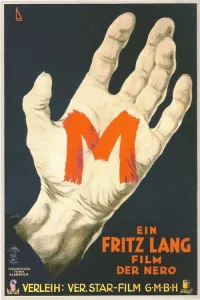The Shadow of Terror: How Fritz Lang's 'M' (1931) Mastered Sound, Suspense, and the Sickness of Society!
In the turbulent, artistically fertile landscape of Weimar Republic Germany, Fritz Lang emerged as a cinematic titan, a visionary director whose monumental films pushed the boundaries of visual storytelling and psychological depth. Having already left an indelible mark with masterpieces of German Expressionism like Metropolis and Dr. Mabuse the Gambler, Lang was poised to revolutionize cinema once again with the advent of synchronized sound. His first sound film, M (1931), stands as an unparalleled achievement, not just a gripping crime thriller, but a profound sociological and psychological study that used the new technology of sound in groundbreaking ways. This film didn't just adapt to sound; it reinvented it, proving its power to amplify suspense, reveal inner thoughts, and create a chilling atmosphere, forever influencing the crime genre and establishing Lang's genius for dissecting the dark undercurrents of urban society.
The film plunges us into the terrifying grip of a child murderer who preys on young girls in a bustling German city. The escalating fear and public outcry become so intense that both the police, under immense pressure to catch the killer, and the city's criminal underworld, whose illicit activities are being disrupted by the heightened police presence, launch their own parallel, desperate hunts. At the center of this manhunt is Hans Beckert (Peter Lorre), a seemingly unassuming man whose whistling of Edvard Grieg's "In the Hall of the Mountain King" becomes his terrifying signature. What unfolds is a chilling cat-and-mouse game where the lines between justice and mob rule blur, and the city's underbelly proves disturbingly efficient in its own brand of retribution. Lang masterfully crafts a narrative that explores themes of collective hysteria, vigilantism, and the inherent criminality that can fester in a fractured society, painting a grim portrait of fear turning into primal vengeance.
Fritz Lang's directorial brilliance in M is evident in every meticulously crafted frame and every strategically deployed sound. He pioneered the use of off-screen sound to create suspense, famously employing Beckert's chilling whistle to signify his presence long before he appears visually. Dialogue is used sparingly but powerfully, allowing the visuals and the carefully constructed soundscape to carry much of the narrative and emotional weight. The cinematography is stark and expressionistic, utilizing shadows and stark contrasts to reflect the moral ambiguity of the characters and the oppressive atmosphere of the city. Lang’s masterful cross-cutting between the police investigation and the criminals' hunt for Beckert creates a relentless tension, ultimately leading to a harrowing "trial" orchestrated by the underworld, questioning the very nature of justice and punishment.
M remains a seminal cult film and a cornerstone of world cinema, revered for its innovative use of sound, its powerful psychological depth, and Peter Lorre's unforgettable, terrifying performance. Lorre, in his breakout role, delivers a haunting portrayal of Hans Beckert, a man consumed by his own unspeakable urges, famously delivering a desperate, chilling monologue at the film's climax that humanizes the monstrous. The film was partially inspired by the real-life serial killer Peter Kürten, the "Vampire of Düsseldorf." It was produced by Nero-Film and is widely considered one of the greatest German films ever made. M stands as a chilling, thought-provoking masterpiece that transcends its genre, a timeless exploration of societal fear and the dark recesses of the human psyche.
Director: Fritz Lang.
Cast: Peter Lorre as Hans Beckert, Ellen Widmann as Mrs. Beckmann, Otto Wernicke as Inspector Lohmann, Gustaf Gründgens as The Safecracker.
Special Info/Trivia: This was Fritz Lang's first sound film, and he famously used sound innovatively, particularly with the killer's off-screen whistle. The film was partially inspired by the real-life German serial killer Peter Kürten, known as the "Vampire of Düsseldorf." Peter Lorre delivered his breakthrough performance in this film, making him an international star. The film explores themes of vigilantism, mob mentality, and the nature of criminality. It is considered a masterpiece of German Expressionism and a foundational work of the crime thriller genre.

